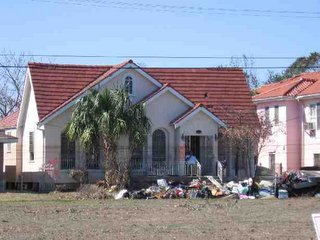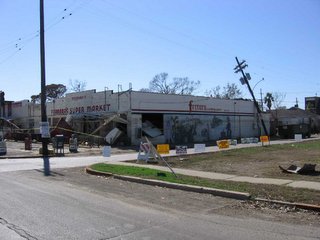Thursday Katrina photos

Other than raising houses on piers, the other flood-prevention possibility is building up lots with fill, as was done in this Gentilly neighborhood (roughly 1920's construction). Note the line of brown caused by brackish water. For many families in New Orleans, how high their homes were raised was the difference between lives radically impacted, and lives inconvenienced.
This past weekend, a friend recounted how his grandmother always marveled at the appearance of houses in the 1950's which were built at ground level on top of concrete slabs. In a city where, historically, the Mississippi River overflowed its banks every spring, building houses on slabs seemed like a willful act of defiance against nature that would one day cause owners grief. In floods like the one in 1915, Nashville Avenue, Uptown, was under 10 feet of water. After the 1927 flood, the banks of the Mississippi were raised by a levee system that contributed to the defiance of heady developers. A lesson was learned again when Hurricane Betsy struck in 1965, but in the intervening 40 years, nothing was done to improve the levee system, and Louisiana's fragile coastline disappeared.
Happily, many pets were rescued ...
... but, sadly, not all made it ...
... nor did some residents.
Lakefront homeowner seated on porch below water line.
Lakefront, near the University of New Orleans: Ferrara Grocery, "Makin' groceries since 1906."
Next time, the Lakeview neighborhood.







2 Comments:
i can't tell you how many 6 packs of beer i've bought from Ferrara's - so sad to see that....
Spitting in a Wishing Well
Yeah, just seeing the place, I remember how it smelled - not sterile like modern supermarkets, but kind of funky like a corner grocer - the smell of butchered meat and cooked food in a closed space.
Post a Comment
<< Home